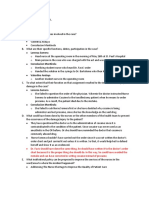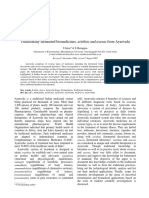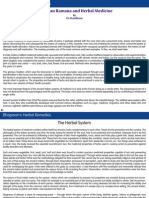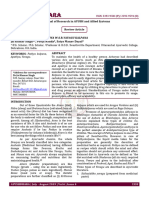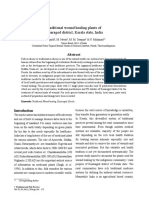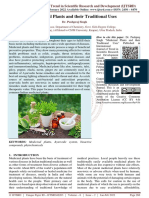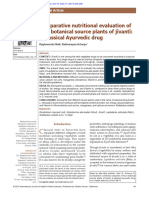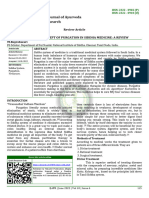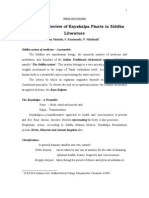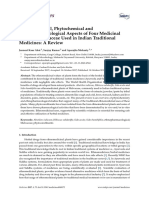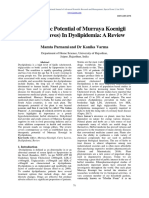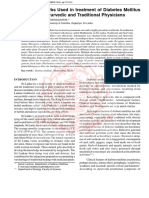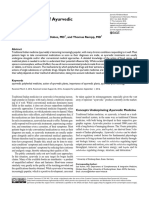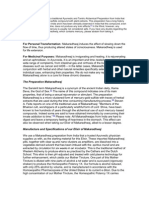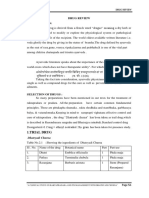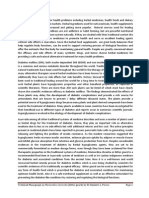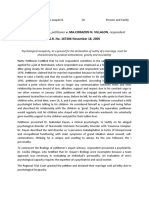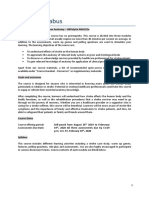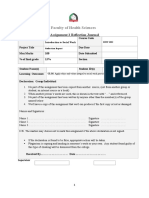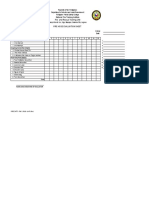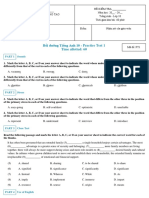A Study On Medicinal Plants Used in Karkidaka Kanj
A Study On Medicinal Plants Used in Karkidaka Kanj
Uploaded by
Neeraj SethiCopyright:
Available Formats
A Study On Medicinal Plants Used in Karkidaka Kanj
A Study On Medicinal Plants Used in Karkidaka Kanj
Uploaded by
Neeraj SethiOriginal Title
Copyright
Available Formats
Share this document
Did you find this document useful?
Is this content inappropriate?
Copyright:
Available Formats
A Study On Medicinal Plants Used in Karkidaka Kanj
A Study On Medicinal Plants Used in Karkidaka Kanj
Uploaded by
Neeraj SethiCopyright:
Available Formats
ISSN: 2322 - 0902 (P)
ISSN: 2322 - 0910 (O)
International Journal of Ayurveda
and Pharma Research
Review Article
A STUDY ON MEDICINAL PLANTS USED IN KARKIDAKA KANJI: A HEALTH TRADITION OF KERALA
Mohan Deepa1*, Sajeevan Aiswaraya2
*1Guest lecturer, 2UG Student, Department of Botany, Bharata Mata College, Thrikkakara, Kerala, India.
ABSTRACT
Karkidakam (July- August) is the last month of Malayalam calendar and is one of the months that fall
under monsoon season. The month is regarded as the most suitable time for rejuvenation therapies.
Karkidaka chikitsa are well known tradition of Kerala, which focuses on detoxification of the body and
prevention of monsoon related diseases. Karkidaka kanji is a medicated porridge consumed by the people
as the part of Karkidaka chikitsa. The Kanji increases the digestive capacity and strengthens the body. It is
believed that the Kanji will be providing immunity for the upcoming year. The present work reveals the
importance of Karkidaka kanji and the plants used in the conventional method of its preparation. The
information regarding the plants used was obtained from the Ayurvedic Doctors, Ayurvedic practitioners
and local people of different regions of Kerala. The study enumerates the list of 87 plant species
belonging to 42 families to be used in the preparation of Karkidaka kanji. The Kanji is generally prepared
using Njavara rice, spices and various other herbs like Sida cordifolia, Boerhavia diffusa, Mimosa pudica,
the extract of ‘Dashapusham’ etc. The ingredients and preparation of Karkidaka kanji varied in different
region according to the availability of plants. These ingredients are therapeutically active source of drug
for various disease and ailments. Still there exist a lot of possibilities for investigating the potential
pharmacological activates of these plants. Thus systematic documentation of such traditional system
indicating the importance of plants opens up the opportunity for future research.
KEYWORDS: Ayurveda, Karkidaka kanji, Karkidakam, Tridosha, Njavara rice.
INTRODUCTION
“Sama dosha, sama agni, sama dhatu malakriyah observation and improvement of daily regimens
Prasanna atmaindriya manaha swastha iti (Dinacharya) and also seasonal regimens
abhidhidheyate” ~ Sushrutastru 24/41 (Rituacharya) with appropriate diet plans for
“Health is achieved when the Tridoshas (biological wellbeing of the individual.
forces- Vata, Pitta and Kapha), and Agni (metabolic In Kerala, Varsharitu (monsoon) comes under
activity) are stable and the excretion process is Visargakala. Karkidakam is the last month of
normal. Swastha (good health) is obtained when the Malayalam calendar and is one of the months that
Atmaa (soul), Indriyas (senses) and Manah (mind) falls under Varsharitu. The Karkidakam is also known
are in coordination with internal peace.” Ayurveda as Dhurghada massam which means risky month.
(Ayur means life and Veda means knowledge) is From the past the month is regarded as a challenging
known as the complete knowledge of life. This period with poverty and scarcity of food.[1] During
traditional system of healthcare focuses on the Karkidakam the monsoon rain will be at its peak. The
mutual relationship between the individual and the earth gets colder due to rain, cold wind, clouds and
nature. This is achieved through physical therapies, moist weather. The decrease in temperature causes
herbal remedies, moderate physical exercises and a unbalance in Tridoshas and results in weakened
proper balanced diet in accordance with the season, digestive process which in turn affect the immunity.[2]
geographical location, times of the day and even the Throughout this period the body is considered to be
heath and emotion of the individual. Ayurveda highly sensitive and food should be restricted to
prescribes regimens for all people in every seasons. maintain good health. Karkidaka chikitsa or
According to Ayurveda a year can be divided Karkidaka therapy is a traditional practice that is
into two phases, the Adanakala and Visargakala. involved in rejuvenating the body. Karkidaka kanji
During Adanakala the body acquires strength and (medicated porridge) is consumed as the part of
Visargakala is the period when the body loses its Karkidaka chikitsa during this month. The Kanji helps
strength. The system also emphasis on the regular to mitigate the imbalance of Tridoshas and also to
improve the digestive activity of the body.[3]
IJAPR | April 2021 | Vol 9 | Issue 4 82
Mohan Deepa, Sajeevan Aiswararya. A Study on Medicinal Plants Used in Karkidaka Kanji: A Health Tradition of Kerala
Karkidaka kanji also known as Marunnu kanji and also hunger. It is served hot and is advised to
or Oushadha kanji, is a special medicated porridge prepare freshly on all days during the month of
which is considered as one of the Rituacharya Karkidakam. The course of consumption can varies
regimens during Karkidakam. The Kanji is prepared from 7 days to the entire month.
with easily digestible cereals, spices, herbs and fresh The Kanji is a special combination of grains,
plant extracts.[4] It is considered ideal for people with spices and fresh plants (mostly herbs). A total of 87
disease like diabetes, hypercholesterolemia, arthritis, plants belonging to 42 families were identified to be
obesity, lumbar and cervical spondylosis etc. Hence it used in the preparation of Karkidaka Kanji (Table 1).
is consumed as Oushadha (medicine) as well as The plant families with most number of species used
Aahara (food). The major ingredients include Oryza included Fabaceae and Apiaceae. Most of the plants
sativa (Njavar rice), Cuminum cyminum, Triticum were used completely for the preparation. Other
aestivum, Trigonella foenum-graecum, Tachyspermum commonly used parts included the leaves and the
ammi etc. A few varieties of spices like Zingiber seeds. The common plant parts used for the
Officinale, Piper nigrum, Elattaria cardamomum, preparation are represented in Figure 1. The main
Syzygium aromaticum etc and many varieties of herbs ingredients used are represented in the Figure 2 & 3.
like Biophytum candolleanum, Cardiospermum Preparation of Karkidaka kanji is one of the
halicacabum, Emilia sonchifolia, Boerhavia diffusa, conventional practices prevailing in Kerala. There
Sida cordifolia, Mimosa pudica etc are also used in the was no strict procedure regarding the ingredients
preparation. These ingredients aids easy digestion used for Karkidaka kanji, but there exists some
and strengthen the body. They serve as excellent regional differences in the preparation across Kerala.
source of carbohydrate, proteins, dietary fibers, A general method of preparation was structured
vitamins and minerals. It is believed that a complete based on the information collected.
course of Karkidaka kanji will provide immunity for
Method of Preparation: All the fresh ingredients are
the whole upcoming year.[5]
chopped and crushed for extracting the juice. The
The preparation of Karkidaka kanji varies extract with equal amount of water is brought to boil.
according to locality and availability of plants, which Njavara rice, green gram, fenugreek, spices and other
are endemic to the region. This knowledge is unique dry ingredients are added to the boiling extract and
and often remains within few communities. The cooked well. Once the rice is cooked coconut milk is
importance of documenting such ethnic practices for added to the mixture. Finally shallots fried in fresh
further reference is of prime importance. Thus the ghee is mixed with the Kanji and served hot. The
present study aimed at documenting the plants used kanji normally taste bitter, so salt or palm Jaggery can
in the preparation of Karkidaka kanji and also to be used to reduce bitterness.
understand the prevailing method of its preparation.
Oryza sativa (Njavara rice) is the prime
MATERIALS AND METHODS important ingredient of Karkidaka kanji irrespective
The investigation was conducted among the of the region. It is endemic to Kerala and is highly
Ayurvedic Doctors, Ayurvedic practitioners and local medicinal. It has both antidiabetic and antioxidant
peoples of different regions of Kerala to collect the properties. Trigonella foenum-graecum (Uluva),
information regarding the various methods, Tachyspermum ammi (Ayamodakam), Zingiber
ingredients and the plants used for the preparation of Officinale (Chukku), Cuminum cyminum (Jerrakam),
Karkidaka kanji. The study was carried out from July Myristica fragrans (Jathikka), Coriandrum sativum
2019 to March 2021. The prevalent method of (Malli), Lepidium sativum (Asali) etc are the main dry
preparation of Karkidaka kanji was recorded along ingredients used in the preparation. The common
with the ingredients used. Photographs of the plants fresh ingredients include Dashapushpam (Aerva
and plant parts were also taken. Vernacular names of lanata, Biophytum candolleanum, Cardiospermum
the medicinal plants mentioned by the local people halicacabum, Curculigo orchioides, Cynodon dactylon,
was clarified with the help of Ayurvedic Doctors. The Eclipta alba, Emilia sonchifolia, Evolvulus alsinoides,
plants used were further authenticated using flora of Ipomea serpiaria and Vernonia cinerea), Boerhavia
the region. diffusa, Sida cordifolia, Strobilanthes ciliatus, Ciccus
RESULTS AND DISCUSSION quadrangularis and Mimosa pudica. The
Karkidaka kanji is an important Aahara which phytochemical and medicinal value of all the
has become a habit of Keralites from centuries. It is a ingredients used in the preparation of Karkidaka
common Ritucharya practiced during the month of kanji are having wide range of health benefits and
Karkidakam. The Kanji is known for eliminating contribute directly for the improvement of general
thirst, tiredness, weakness, abdominal discomfort health of the individual.
IJAPR | April 2021 | Vol 9 | Issue 4 83
Int. J. Ayur. Pharma Research, 2021;9(4):82-89
Table 1: The common plants used in Karkidaka Kanji with their vernacular name, family and used parts
S.No Botanical name Vernacular name Family Useful part
1 Achyranthes aspera Vankadaladi Amaranthaceae Whole plant
2 Aegle marmelos Koovalam Rutaceae Root
3 Aerva lanata Cheroola Amranthaceae Whole plant
4 Allium cepa Cheriyaulli Liliaceae Tuber
5 Amaranthus spinosus Mullan cheera Amranthaceae Whole plant
6 Anethum graveolens Chathakuppa Apiaceae Seeds
7 Artocarpus heterophyllus Plaavu Moraceae Leaves
8 Baccopa monnieri Brahmi Plantaginaceae Whole plant
9 Benincasa hispida Kumbalam Cucurbitaceae Tender leaves
10 Biophytum candolleanum Mukkutty Oxalidaceae Whole plant
11 Boerhavia diffusa Thazhuthama Nyctaginaceae Whole plant
12 Borassus flabellifer Karimpana Arecaceae Inflorescence
13 Brassica nigra Kadukku Brassicaceae Seeds
14 Capsicum frutescens Kantharikoddi Solanaceae Stem & leaves
15 Cardiospermum halicacabum Uzhinja Sapindaceae Stem & leaves
16 Cassia tora Thakara Fabaceae Leaves
17 Centella asiatica Kuddavan Apiaceae Whole plant
18 Ciccus quadrangularis Changalamparanda Vitaceae Stem
19 Clerodoendrum infortunatum Peringanam Verbenaceae Whole plant
20 Clerodoendrum phlomidis Munja Verbenaceae Root
21 Cocos nucifera Thenghu Aracaceae Fruit
22 Coriandrum sativum Malli Apiaceae Seed & leaves
23 Cucurbita moschata Mathan Cucurbitaceae Tender leaves
24 Cuminum cyminum Nallajeerakam Apiaceae Fruit
25 Curculigo orchioides Nilappana Hypoxidaceae Tuber
26 Curcuma longa Manjal Zingiberaceae Rhizome
27 Cyclea peltata Padathalli Menispermaceae Stem & leaves
28 Cynodon dactylon Karuka Poaceae Leaves
29 Desmodium gangeticum Orila Fabaceae Root
30 Eclipta alba Kayyunyam Asteraceae Stem & leaves
31 Elattaria cardamomum Elam Zingiberaceae Seeds
32 Elephantopus scaber Anachuvadi Asteraceae Whole plant
33 Embelia ribes Vizhalari Myrsinaceae Seeds
34 Emilia sonchifolia Muyalcheviyan Asteraceae Stem & leaves
35 Euphorbia thymifolia Nilappaala Euphorbiaceae Whole plant
36 Evolvulus alsinoides Vishnukranthi Convulvulaceae Whole plant
37 Glycosmis pentaphylla Kuttipannal Rutaceae Stem & leaves
38 Gmelina arborea Kumizhu Verbenaceae Root
39 Hemidesmus indicus Nannari Asclepiadaceae Leaves
Available online at: http://ijapr.in 84
Mohan Deepa, Sajeevan Aiswararya. A Study on Medicinal Plants Used in Karkidaka Kanji: A Health Tradition of Kerala
40 Holarrhena pubescens Kudakapaalari Apocynaceae Seeds
41 Illicium verum Thakkolam Schisandraceae Fruit
42 Inula racemosa Pushkaramulam Asteraceae Root
43 Ipomea serpiaria Thiruthali Convolvulaceae Whole plant
44 Ixora coccinea Chethi Rubiaceae Stem & leaves
45 Justicia adhatoda Aadalodakam Acanthaceae Stem & leaves
46 Lepidium sativum Asali Brassicaceae Seeds
47 Lucas aspera Thumba Lamiaceae Whole plant
48 Messua ferrea Nagapoov Clusiaceae Flower
49 Metroxylon saghu Chowarri Arecaceae Stem pith
50 Microstachys chamaelea Kodiaavanaku Euphorbiaceae Whole plant
51 Mimosa pudica Thottavadi Mimosea Whole plant
52 Morinda umbellata Kudalchuruki Rubiaceae Whole plant
53 Moringa oleifera Murringa Moringaceae Bark
54 Mucrotyloma uniflorum Muthira Fabaceae Seeds
55 Murraya koenigii Veppu Rutaceae Leaves
56 Myristica fragrans Jathikka Myristicaceae Seeds
57 Myxopyrum serratulum Chathurramulla Oleaceae Leaves
58 Naravelia zeylanica Vathakoddi Ranunculaceae Stem & leaves
59 Naregamia alata Nilanarakam Rutaceae Whole plant
60 Nigella sativa Karimjeerakam Ranunculaceae Fruit
61 Ocimum sanctum Krishna thulasi Lamiaceae Whole plant
62 Oroxylum indicum Palaka payyani Bignoniaceae Root
63 Oryza sativa Njavara rice Poaceae Seeds
64 Oxalis corniculata Pulliarella Oxalidaceae Whole plat
65 Phyllanthus niruri Kizharnelli Euphorbiaceae Whole plant
66 Piper longum Thippili Piperaceae Fruit
67 Piper nigrum Kurumulaku Piperaceae Fruit
68 Plectranthus amboinicus Panikurka Lamiaceae Leaves
69 Pseudarthria viscida Moovila Fabaceae Root
70 Psidium guajava Perra Myrtaceae Leaves
71 Psoralia corylifolia Karkolarri Fabaceae Seeds
72 Sida cordifolia Kurunthotti Malvaceae Root
73 Solanum indicum Cheruvazhuthana Solanaceae Root
74 Solanum surattense Kantakari chunda Solanaceae Root
75 Stereospermum suaveolens Paathiri Bignoniaceae Root
76 Strobilanthes ciliatus Karimkurinji Acanthaceae Root
77 Syzygium aromaticum Karayampoovu Myrtaceae Flower bud
78 Tachyspermum ammi Ayamodakam Apiaceae Seeds
79 Tamarindus indica Pulli Fabaceae Leaves
80 Tribulus terrestris Njjerinjhil Zygophyllaceae Root
IJAPR | April 2021 | Vol 9 | Issue 4 85
Int. J. Ayur. Pharma Research, 2021;9(4):82-89
81 Trigonella foenum-graecum Uluva Apiaceae Seeds
82 Triticum aestivum Nurku gothambu Poaceae Seeds
83 Vernonia cinerea Puvamkurunnel Asteraceae Whole plant
84 Vigna radiata Cherrupayar Fabaceae Seeds
85 Vitex altissima Mylellu Verbenaceae Seeds
86 Vitex negundo Karinechi Verbenaceae Stem & leaves
87 Zingiber Officinale Chukku Zingiberaceae Rhizome
Parts used
Flower Fruit Inflorescenc
Whole plant 2% 6% e
22% 1%
Leaves
Tuber 23%
2%
Stem pith
Stem 1%
11%
Rhizome
2%
Root
Seeds
13%
17%
CONCLUSION
Kerala is recognized for its ethnic customs in different region according to the availability of
and unique traditions. It is one among the states that plants.
receives the largest monsoon during the year. The The rejuvenating effect of Karkidaka kanji is a
monsoon rains are heaviest during the month of well-established tradition of Kerala. Systematic
Karkidakam. As per the tradition of Kerala, people documentation and subsequent screening on
follow various therapies during Karkidakam to phytochemicals of these plants contribute for
strengthen the body that helps them to withstand the potential drug development in Ayurveda and other
monsoon related problems. disciplines of medicine. It can also shed light towards
Karkidaka kanji is a medicated porridge made understanding more about the prevailing
using easily digestible cereals, spices, herbs and fresh biodiversity of the area. Thus by following such
plant extracts. The admiration of Karkidaka kanji traditional system can contribute towards
provide promising results due to the phytochemical conservation of biodiversity and to lead a
properties and therapeutical values of cereals, spices harmonious life with nature.
and plants used for its preparation. In the present REFERENCE
study, 87 plants belonging to 42 families are 1. Customs and rituals related to Holy Month
documented as plants used in the preparation of Karkidakam. Boddunan: information creates
Karkidaka kanji. Oryza sativa, Trigonella foenum- wealth: customs and culture; 2013 [cited 2013
graecum, Tachyspermum ammi, Zingiber Officinale, July 17]. Available form: https://www.boddunan.
Cuminum cyminum, Coriandrum sativum, the juice of com/articles/people-places/59-customs-and-
medicinal herbs called “Dashapushpa”, Boerhavia culture/22791-customs-and-rituals-related-to-
diffusa, Sida cordifolia, Mimosa pudica etc are the holy.html
main ingredients used in the preparation. The
2. Gloria Maria Winnie. A Study on Medicinal Plants
ingredients and preparation of Karkidaka kanji varies
used in ‘Karkidaka Kanji’: The Ayurvedic
Available online at: http://ijapr.in 86
Mohan Deepa, Sajeevan Aiswararya. A Study on Medicinal Plants Used in Karkidaka Kanji: A Health Tradition of Kerala
Medicine. International Journal of Scientific 11. Udayan P, George S, Thushar K, Balachandran I.
Research in Science, Engineering and Technology. Ethnomedicinal Plants used by the Oorali tribes of
2018; 4(9): 303-309. Idukki dist. Kerala state. Indian Journal of
3. Vijaya Lekshmi R, Shajahan M A, Indulekha V C. Economic and Taxonomic Botany. 2005; 29(1):
Ethnobotany of Kerala’s Karkidaka Kanji 217-223.
(medicated porridge). International Journal of 12. Walter H. Lewis, Memory P. F, Elvin‐Lewis M.
Ayurveda and Pharma Research. 2019; 7(8): 58- Medical Botany: Plants affecting man's health.
62. New York. John Wiley & Sons. 1977; 26(4): 461.
4. Rakesh Kumar. Karkidaka Treatment: The 13. Wen-Chieh C, Burton J, Bannerman R. Traditional
Scientific way. Ayurpub. 2016; 1(3): 89-9. Medicine and Health Care Coverage - a Reader for
5. Unnikrishnan E. Materia Medica of the Local Health Administrators and Practitioners. Journal
Health Traditions of Payyannur. Vol.-1. of Modern African Studies. 1983; 22(4): 695.
Thiruvananthapuram; Kerala Research 14. Madhavankutty K. Tribal System of Medicine: A
Programme on Local Level Development; 2017. study of the Herbs and Medical Measure used by
p.15-16. Tribals of Kerala. Thiruvananthapuram. KANFED;
6. Menon M V, Potty N N. Njavara: a Unique Race of 1989.
Humid Tropics. International Journal of Rice 15. Job Thomas. Rejuvenating Kerala.
Research. 1997: 22(3): 1-19. Thiruvananthapuram. Orange printers; 2009. p.
7. Yoganarisimhan S N. Medicinal Plants of India. 48-51.
Bangalore; Cyber Media; 2000. p. 136-137. 16. Jiny Varghese K, Anila J, Nagalekshmi R, Resiya S,
8. Manjusha Choudhary. Medicinal Plants with Sonu J. Dasapushpam: The Traditional uses and
Potential Anti Arthritic Activity. Journal of the Therapeutic Potential of Ten Sacred Plants of
Intercultural Ethnopharmacology. 2015; 4(2): Kerala State in India. International Journal of
147–179. Pharmaceutical Sciences and Research. 2010;
9. Varma C R R. Plants used in Nature Cure. 1(10): 50-59.
Proceedings of Seminar on Medicinal plants, 17. Yogini S. J, Leonard L. W. A glimpse of Ayurveda -
K.F.R.I. Peechi. 1981. The forgotten history and principles of Indian
10. Udayan P, Balachandran I. Medicinal Plants of traditional medicine. Journal of Traditional and
Arya Vaidya Sala Herb Garden. Kottakkal Arya Complementary Medicine. 2017; 7: 50-53.
Vaidya Sala; Kerala. 2009; (1): 17-385.
*Address for correspondence
Cite this article as:
Deepa Mohan
Mohan Deepa, Sajeevan Aiswaraya. A Study on Medicinal Plants Used in
Karkidaka Kanji: A Health Tradition of Kerala. International Journal of Ayurveda
Guest lecturer
and Pharma Research. 2021;9(4):82-89. Department of Botany,
Source of support: Nil, Conflict of interest: None Declared Bharata Mata College,
Seaport-Airport road,
Thrikkakara, Edapally, Kochi, Kerala.
Email:
deepamohan1818@gmail.com
Phone number: 0484-2425121
Disclaimer: IJAPR is solely owned by Mahadev Publications - dedicated to publish quality research, while every effort has been taken to verify
the accuracy of the content published in our Journal. IJAPR cannot accept any responsibility or liability for the articles content which are
published. The views expressed in articles by our contributing authors are not necessarily those of IJAPR editor or editorial board members.
IJAPR | April 2021 | Vol 9 | Issue 4 87
Int. J. Ayur. Pharma Research, 2021;9(4):82-89
Figure 1: The parts of plants used in the preparation of Karkidaka kanji
Fig. 2: a.Oryza sativa, b.Trigonella foenum-graecum, c.Tachyspermum ammi, d.Cuminum cyminum, e.Coriandrum
sativum, f.Lepidium sativum, g.Zingiber Officinale, h.Piper longum, i.Piper nigrum, j.Elattaria cardamomum,
k.Vigna radiate, l.Myristica fragrans,m.Sida cordifolia, n.Boerhavia diffusa, o.Lucas aspera.
Available online at: http://ijapr.in 88
Mohan Deepa, Sajeevan Aiswararya. A Study on Medicinal Plants Used in Karkidaka Kanji: A Health Tradition of Kerala
Fig. 3: a.Aerva lanata, b.Biophytum candolleanum, c.Cardiospermum halicacabum, d.Curculigo orchioides,
e.Cynodon dactylon, f.Eclipta alba, g.Emilia sonchifolia, h.Evolvulus alsinoides, i.Ipomea serpiaria, j.Vernonia
cinerea, k.Centella asiatica, l.Ciccus quadrangularis, m.Mimosa pudica.
IJAPR | April 2021 | Vol 9 | Issue 4 89
You might also like
- Ayush 100 Recipes EnglishDocument53 pagesAyush 100 Recipes EnglishLaura Villalobos100% (1)
- Aquino, Kristine Camille V. BSN Iv-C Group 3Document1 pageAquino, Kristine Camille V. BSN Iv-C Group 3KheyCee Valdez Aquino100% (1)
- Kerela KANJIDocument5 pagesKerela KANJIBhavana GangurdeNo ratings yet
- Traditional Seasonal Health Food Practices in Southwest India: Nutritional and Medicinal PerspectivesDocument5 pagesTraditional Seasonal Health Food Practices in Southwest India: Nutritional and Medicinal PerspectivesSachin KumarNo ratings yet
- Guduchi Review 2Document4 pagesGuduchi Review 2Mulayam Singh YadavNo ratings yet
- Chem PDFDocument4 pagesChem PDFAnchal JhaNo ratings yet
- Recent Approaches of Ayurveda For Karshya: A ReviewDocument4 pagesRecent Approaches of Ayurveda For Karshya: A ReviewEditor_IAIMNo ratings yet
- Yavagu PathyakalpanaDocument5 pagesYavagu PathyakalpanaSamhitha Ayurvedic ChennaiNo ratings yet
- Asavas Arishtas 2 PDFDocument9 pagesAsavas Arishtas 2 PDFc108No ratings yet
- Bhagavan Ramana and Herbal Medicine - Dr. ManikkamDocument8 pagesBhagavan Ramana and Herbal Medicine - Dr. Manikkamdeepaksubsmani@yahoo.com100% (3)
- Therapeutic and Nutritional Values of Narikelodaka (Tender Coconut Water) - A ReviewDocument8 pagesTherapeutic and Nutritional Values of Narikelodaka (Tender Coconut Water) - A ReviewChristian Janus GATILLONo ratings yet
- Role of Pathya Aahara Kalpana (Diet) in Maintenance of Healthy LifestyleDocument4 pagesRole of Pathya Aahara Kalpana (Diet) in Maintenance of Healthy LifestylekavalapparaNo ratings yet
- SpicesDocument8 pagesSpiceshopesosomaNo ratings yet
- How To Consume Yuvagu AyurvedicDocument5 pagesHow To Consume Yuvagu AyurvedicdimitriNo ratings yet
- 1376-Article Text-3333-1-10-20231110Document4 pages1376-Article Text-3333-1-10-20231110anishnair87gmailcomNo ratings yet
- Pathya Aahara Kalpana AReviewDocument10 pagesPathya Aahara Kalpana AReviewVinay WaliaraoNo ratings yet
- AnandChaudharyetalAYUSandhanKalpana ReviewDocument11 pagesAnandChaudharyetalAYUSandhanKalpana ReviewRaj SinghNo ratings yet
- 491-Article Text-1441-1-10-20161206Document16 pages491-Article Text-1441-1-10-20161206Vande GuruParamparaNo ratings yet
- Sacred Offerings and Sustainable PracticesDocument4 pagesSacred Offerings and Sustainable PracticesJayadevi ShanmugamNo ratings yet
- Traditional Wound Healing Plants of Kasaragod District, Kerala State, IndiaDocument10 pagesTraditional Wound Healing Plants of Kasaragod District, Kerala State, IndiaVakamalla SubbareddyNo ratings yet
- Medicinal Uses of Spices Used in Our Traditional Culture: World WideDocument8 pagesMedicinal Uses of Spices Used in Our Traditional Culture: World WideYitbarek AbrhamNo ratings yet
- Progressive Review of Sandana KalpanaDocument18 pagesProgressive Review of Sandana Kalpanavipra ayurvedaNo ratings yet
- Medicinal Plants and Their Traditional UsesDocument11 pagesMedicinal Plants and Their Traditional UsesEditor IJTSRDNo ratings yet
- 49-Article Text-150-1-10-20151208Document4 pages49-Article Text-150-1-10-20151208Rakesh MacherlaNo ratings yet
- Ayurvedic Renaissance 2011 Jan - MarDocument32 pagesAyurvedic Renaissance 2011 Jan - MarHinduism EbooksNo ratings yet
- BMMADocument23 pagesBMMASachin thapliyalNo ratings yet
- 17 ChavanprashDocument10 pages17 ChavanprashJithinNo ratings yet
- Comparative Nutritional Evaluation of Four Botanical Source Plants of Jīvantī: A Classical Ayurvedic DrugDocument6 pagesComparative Nutritional Evaluation of Four Botanical Source Plants of Jīvantī: A Classical Ayurvedic DrugRaghuNo ratings yet
- Ayurvedic Medicines: Books - CDDocument4 pagesAyurvedic Medicines: Books - CDAnonymous f5gNPeZDCNo ratings yet
- Navara - RiceDocument3 pagesNavara - RiceRavi ShankarNo ratings yet
- Understanding_the_Concept_of_Purgation_in_Siddha_MDocument8 pagesUnderstanding_the_Concept_of_Purgation_in_Siddha_Mjayztet3No ratings yet
- Praise PDFDocument5 pagesPraise PDFvimsy20No ratings yet
- article_1680257103Document5 pagesarticle_1680257103ADITI GUPTANo ratings yet
- Ayurpharm 35Document11 pagesAyurpharm 35jaya2504No ratings yet
- Work of ResearchDocument4 pagesWork of ResearchMansiNo ratings yet
- Aspects of Four Medicinal Plants of Malvaceae Used in Indian Traditional MedicinesDocument33 pagesAspects of Four Medicinal Plants of Malvaceae Used in Indian Traditional Medicinesryder grayNo ratings yet
- Asava and Aristha An Ayurvedic Medicine - An OvervDocument8 pagesAsava and Aristha An Ayurvedic Medicine - An Overvshubh.r.goriNo ratings yet
- Therapeutic Potential of Murraya Koenigii in Dyslipidemia:A ReviewDocument5 pagesTherapeutic Potential of Murraya Koenigii in Dyslipidemia:A ReviewMamta ParnamiNo ratings yet
- Medicinal Plant NotesDocument31 pagesMedicinal Plant NotesBunnyNo ratings yet
- Xclzear DocumentDocument19 pagesXclzear Documentashwarya_me_er5146No ratings yet
- The Significance of Ayurvedic Medicinal PlantsDocument8 pagesThe Significance of Ayurvedic Medicinal PlantsYiru ShiNo ratings yet
- Traditional Herbal Medicines Used for the Treatment of DiabetesDocument7 pagesTraditional Herbal Medicines Used for the Treatment of DiabeteskarthikeyanthanjavurNo ratings yet
- Ô Y Makaradhwaj Induces The Effect of Slowing Down TheDocument3 pagesÔ Y Makaradhwaj Induces The Effect of Slowing Down TheshashividyaNo ratings yet
- A Conceptual Review of Properties of Olive Oil As Per Ayurveda With Special Reference To Anukta DravyaDocument4 pagesA Conceptual Review of Properties of Olive Oil As Per Ayurveda With Special Reference To Anukta DravyaTIRUNAGIRI PRANAV SAINo ratings yet
- Critical Review of Dietetics in AyurvedaDocument14 pagesCritical Review of Dietetics in AyurvedakavalapparaNo ratings yet
- 5.drug ReviewDocument10 pages5.drug ReviewKrishnaNo ratings yet
- Kollaetal PDFDocument13 pagesKollaetal PDFDnyaneshwar Dattatraya PhadatareNo ratings yet
- A Compilation of Bioactive Compounds From AyurvedaDocument11 pagesA Compilation of Bioactive Compounds From AyurvedaAhmed Ismail SabriNo ratings yet
- Article 1504177726Document5 pagesArticle 1504177726Otters ClubNo ratings yet
- Pharmacological-Activities-Of-Turmeric-Curcuma-Longa-Linn-A-Review-2167-1206.1000133 (1) - With-Cover-Page-V2Document6 pagesPharmacological-Activities-Of-Turmeric-Curcuma-Longa-Linn-A-Review-2167-1206.1000133 (1) - With-Cover-Page-V2Harold JeffersonNo ratings yet
- Potential of Herbal Nutraceuticals in Ghee A ReviewDocument5 pagesPotential of Herbal Nutraceuticals in Ghee A Reviewkamal gandhiNo ratings yet
- Foodarticle - AyurvedaDocument11 pagesFoodarticle - Ayurvedasrilalitha avinashNo ratings yet
- Arogyavardhini Vati AtheoriticalanalysisDocument4 pagesArogyavardhini Vati AtheoriticalanalysisKinjal SharmaNo ratings yet
- Standardization of Erandamooladi Kwatha Churna - A Compound Formulation Used in Medicated Enema Therapy (Basti Karma)Document8 pagesStandardization of Erandamooladi Kwatha Churna - A Compound Formulation Used in Medicated Enema Therapy (Basti Karma)Suhas ManjunathNo ratings yet
- Sri Lanka HerbsDocument19 pagesSri Lanka HerbsNetera Publishing100% (1)
- Curcuma Zedoaria Rosc White Turmeric A Review of IDocument11 pagesCurcuma Zedoaria Rosc White Turmeric A Review of ITri WardanaNo ratings yet
- Bitter Gourd ReportDocument44 pagesBitter Gourd ReportMillenium Ayurveda100% (1)
- Ayurveda: Balance and Heal Naturally Using Ayurvedic Principles (Embark on a Culinary Journey to Well-being With Ayurvedic Delights)From EverandAyurveda: Balance and Heal Naturally Using Ayurvedic Principles (Embark on a Culinary Journey to Well-being With Ayurvedic Delights)No ratings yet
- PERSONS - VILLANON v. VILLANON G.R. No. 167206Document2 pagesPERSONS - VILLANON v. VILLANON G.R. No. 167206Doogie ReynaldoNo ratings yet
- POLY Anatomy PDFDocument2 pagesPOLY Anatomy PDFGady SzeNo ratings yet
- Ida Jean OrlandoDocument10 pagesIda Jean OrlandoHamza IshtiaqNo ratings yet
- Reflection Report CLO 2.Document4 pagesReflection Report CLO 2.fatma khaledNo ratings yet
- Portfolio in Human Resource ManagementDocument22 pagesPortfolio in Human Resource ManagementErlene LinsanganNo ratings yet
- Summary Notes - Topic 1 Edexcel (A) Biology A LevelDocument10 pagesSummary Notes - Topic 1 Edexcel (A) Biology A LevelAmal Abu KhalilNo ratings yet
- PDP - Case StudyDocument8 pagesPDP - Case StudyJeeshan IdrisiNo ratings yet
- How Old Is The Youngest Mother in The World - Google SearchDocument1 pageHow Old Is The Youngest Mother in The World - Google SearchОюу-Эрдэнэ Э.No ratings yet
- BLB Plan PDFDocument9 pagesBLB Plan PDFAngeliqueSaintNo ratings yet
- Security in The Contemporary WorldDocument4 pagesSecurity in The Contemporary Worldbhandariawadhi31No ratings yet
- 5.0 Reading-Multiple Choice Type 1-Model PracticeDocument2 pages5.0 Reading-Multiple Choice Type 1-Model PracticeMing NgọcNo ratings yet
- Daftar Obat Floorstock RuanganDocument3 pagesDaftar Obat Floorstock Ruangandini mahdianiNo ratings yet
- CMS-DOC-01 Rev6 NASA Competency DictionaryDocument77 pagesCMS-DOC-01 Rev6 NASA Competency DictionaryluzgsaNo ratings yet
- Post Diwali Detox ChallengeDocument4 pagesPost Diwali Detox ChallengeAditya MehtaNo ratings yet
- BLUE2023 - MED1 1.2 Methods of Physical ExaminationDocument3 pagesBLUE2023 - MED1 1.2 Methods of Physical ExaminationcaroairajoysNo ratings yet
- Pleural EffusionDocument3 pagesPleural EffusionRafahiah HaronNo ratings yet
- Emotify: Predict Interpersonal, Team and Leadership EffectivenessDocument2 pagesEmotify: Predict Interpersonal, Team and Leadership EffectivenessNisharNo ratings yet
- Fire and Rescue Training Unit Fire Hose Evaluation SheetDocument2 pagesFire and Rescue Training Unit Fire Hose Evaluation SheetBfp Caraga Trento FSNo ratings yet
- Sagittal Saw SystemDocument7 pagesSagittal Saw Systemjimena lopez cardenasNo ratings yet
- Bồi dưỡng Tiếng Anh 10 - Practice Test 1 - PT1Document6 pagesBồi dưỡng Tiếng Anh 10 - Practice Test 1 - PT1tran quangNo ratings yet
- NCP - Activity IntoleranceDocument4 pagesNCP - Activity IntoleranceRoyce Vincent TizonNo ratings yet
- 1... Tell Me Something About Itself... ?: AnswerDocument12 pages1... Tell Me Something About Itself... ?: AnswerMuhammad BilalNo ratings yet
- Phototherap YDocument25 pagesPhototherap YShivangi SharmaNo ratings yet
- Hepburn X Sheiko BlendDocument8 pagesHepburn X Sheiko Blendvidso90% (10)
- Ultra-Conservative Management of The Discolored Tooth - Spear EducationDocument29 pagesUltra-Conservative Management of The Discolored Tooth - Spear Educationfdnbqkm965No ratings yet
- TCF - Contractor's Site Safety ProgrameditedDocument148 pagesTCF - Contractor's Site Safety ProgrameditedSabre Alam0% (1)
- Satyapriya Madam Topic 2Document16 pagesSatyapriya Madam Topic 2vani reddyNo ratings yet
- Nursery - Community HelpersDocument2 pagesNursery - Community HelpersHeena JainNo ratings yet
- Autism Social SkillsDocument7 pagesAutism Social SkillsAfni Wahyuni0% (1)

